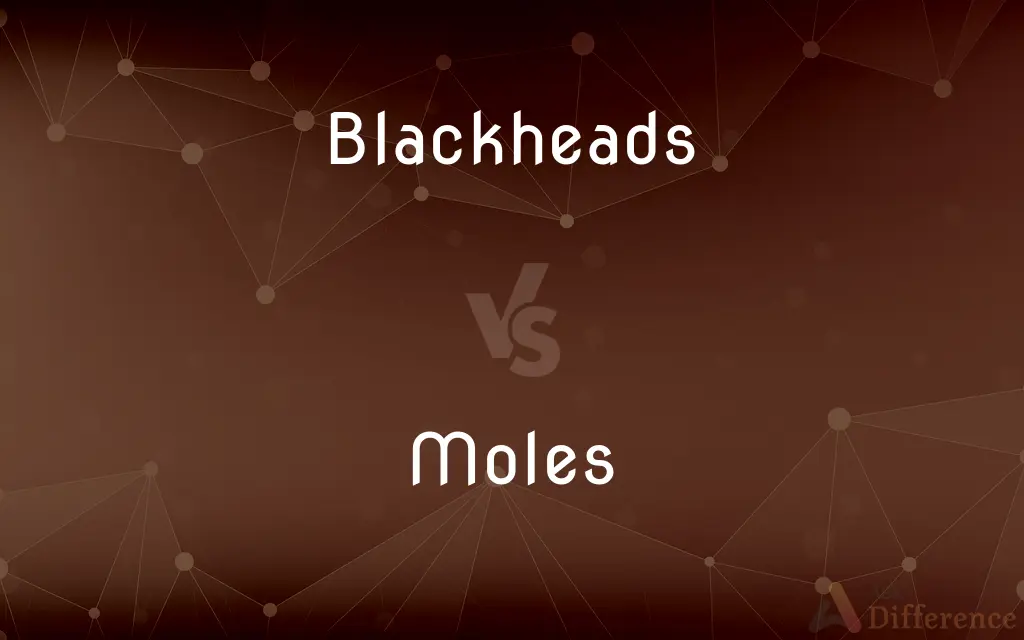Blackheads vs. Moles — What's the Difference?
Edited by Tayyaba Rehman — By Maham Liaqat — Published on April 4, 2024
Blackheads are small, dark lesions caused by clogged hair follicles on the skin, while moles are growths that develop when pigment cells cluster together.

Difference Between Blackheads and Moles
Table of Contents
ADVERTISEMENT
Key Differences
Blackheads, also known as open comedones, form when hair follicles become clogged with a mix of sebum and dead skin cells. The exposed surface of the clog becomes oxidized and turns black, hence the name "blackhead." In contrast, moles are skin growths that occur when melanocytes, the cells that give skin its pigment, grow in clusters instead of being spread throughout the skin. Moles can appear anywhere on the body and vary in color, size, and shape.
While blackheads are often associated with acne and can appear on the face, chest, back, and shoulders, moles are usually benign skin growths that can develop anywhere on the body, including areas not typically prone to acne, like the scalp or beneath the nails. This distinction highlights the difference in their causes and typical locations on the body.
One of the key differences between blackheads and moles is their potential for change over time. Blackheads can often be removed through cleansing, exfoliation, or professional extraction and are not permanent. Moles, on the other hand, are generally permanent skin features and can change in size, shape, or color over time. Changes in moles should be monitored as they can sometimes indicate skin cancer.
Blackheads are primarily a cosmetic concern and do not typically require medical attention unless they are severe or lead to acne complications. Moles, while usually benign, should be monitored for any signs of melanoma, especially if they change in size, shape, color, or texture, or if they bleed, itch, or become painful.
In terms of treatment, blackheads can be addressed with over-the-counter treatments, such as salicylic acid or benzoyl peroxide, and through routine skincare practices. Moles, if problematic, can be removed by a healthcare professional through various methods such as surgical excision, shaving, or laser removal, particularly if there is a concern for melanoma.
ADVERTISEMENT
Comparison Chart
Cause
Clogged hair follicles
Clusters of melanocytes
Appearance
Small, dark spots with open surface
Varied in color, size, shape; usually raised
Location
Face, chest, back, shoulders
Anywhere on the body
Change Over Time
Can be removed; not permanent
Generally permanent; can change in appearance
Medical Concern
Cosmetic, related to acne
Potential for melanoma; requires monitoring
Treatment
Cleansing, exfoliation, OTC products
Monitoring, surgical removal if necessary
Compare with Definitions
Blackheads
A small, dark lesion caused by an oxidized clog of sebum and dead skin cells in a hair follicle.
She used a gentle exfoliator to remove the blackheads on her nose.
Moles
Skin cells that produce melanin, the pigment that gives skin its color, and can cluster to form moles.
The concentration of melanocytes within the mole gave it a dark brown color.
Blackheads
The process that turns the surface of a blackhead black when exposed to air.
The oxidation of the clogged material is what distinguishes blackheads from other forms of acne.
Moles
A growth on the skin that forms when pigment cells (melanocytes) cluster.
The dermatologist checked the mole on his back during the annual skin exam.
Blackheads
A skin condition that can include blackheads as one of its manifestations.
Her acne treatment targeted both pimples and blackheads for clearer skin.
Moles
Describes moles that are non-cancerous and not harmful.
The biopsy confirmed that the mole on her arm was benign.
Blackheads
Another term for a blackhead, referring to the open surface that leads to oxidation.
Regular cleansing helped reduce the appearance of open comedones on his forehead.
Moles
A medical doctor specializing in the treatment of skin conditions, including moles.
He visited the dermatologist yearly for a check-up on his moles to ensure they remained healthy.
Blackheads
The natural oil produced by the skin, which can contribute to blackheads when overproduced.
Excess sebum production in her T-zone often led to blackheads.
Moles
A type of skin cancer that can develop from moles, especially from those that change in size, shape, or color.
Regular monitoring of moles is important for early detection of melanoma.
Blackheads
A skin lesion consisting of a hair follicle that is occluded with sebum and keratin, appearing black at the surface.
Moles
A skin lesion, commonly a nevus, that is typically raised and discolored.
Blackheads
An infectious disease of turkeys and some wildfowl that is caused by a protozoan (Histomonas meleagridis) and results in lesions of the intestine and liver. Also called enterohepatitis, histomoniasis, infectious enterohepatitis.
Moles
A massive, usually stone wall constructed in the sea, used as a breakwater and built to enclose or protect an anchorage or a harbor.
Blackheads
Any of various birds, such as the scaup, with dark head markings.
Moles
Plural of mole
Blackheads
Plural of blackhead
Common Curiosities
Should all moles be removed?
No, only moles that change in size, shape, color, or texture, or that are otherwise concerning, should be evaluated by a dermatologist for possible removal.
Is it safe to remove blackheads at home?
While gentle exfoliation can help, it's important to avoid excessive or harsh methods that can damage the skin.
How often should moles be checked?
Moles should be checked annually by a dermatologist or more frequently if you notice any changes.
Are moles hereditary?
Yes, the tendency to develop moles can be hereditary, and some types of moles may run in families.
Can blackheads turn into pimples?
Yes, if the follicle becomes infected or further clogged, blackheads can develop into pimples.
Is it normal for new moles to appear?
Yes, it's normal for new moles to appear, especially in children and young adults, but new moles in older adults should be checked.
How can you tell a blackhead from a mole?
Blackheads are small, dark spots with an open surface, while moles are usually raised and can vary in color.
Are blackheads a sign of poor hygiene?
Not necessarily; blackheads are often caused by natural skin oil and dead skin cells, not just poor hygiene.
Can moles develop into cancer?
Yes, moles can potentially develop into melanoma, a type of skin cancer, which is why monitoring changes is crucial.
What causes blackheads to form?
Blackheads form due to clogged hair follicles from a combination of sebum and dead skin cells.
Can wearing makeup cause blackheads?
Heavy or comedogenic makeup can contribute to clogged pores, potentially leading to blackheads.
Do moles grow over time?
Moles can grow and change over time, which is why monitoring them is important.
What is the best treatment for blackheads?
Gentle cleansing, exfoliation, and over-the-counter products containing salicylic acid or benzoyl peroxide can be effective.
What does a concerning mole look like?
A concerning mole may change in size, shape, color, is asymmetrical, has irregular borders, or experiences other changes.
How can I prevent blackheads?
Regular skin cleansing, using non-comedogenic products, and gentle exfoliation can help prevent blackheads.
Share Your Discovery

Previous Comparison
Sharara vs. Gharara
Next Comparison
Silos vs. SiloesAuthor Spotlight
Written by
Maham LiaqatEdited by
Tayyaba RehmanTayyaba Rehman is a distinguished writer, currently serving as a primary contributor to askdifference.com. As a researcher in semantics and etymology, Tayyaba's passion for the complexity of languages and their distinctions has found a perfect home on the platform. Tayyaba delves into the intricacies of language, distinguishing between commonly confused words and phrases, thereby providing clarity for readers worldwide.















































